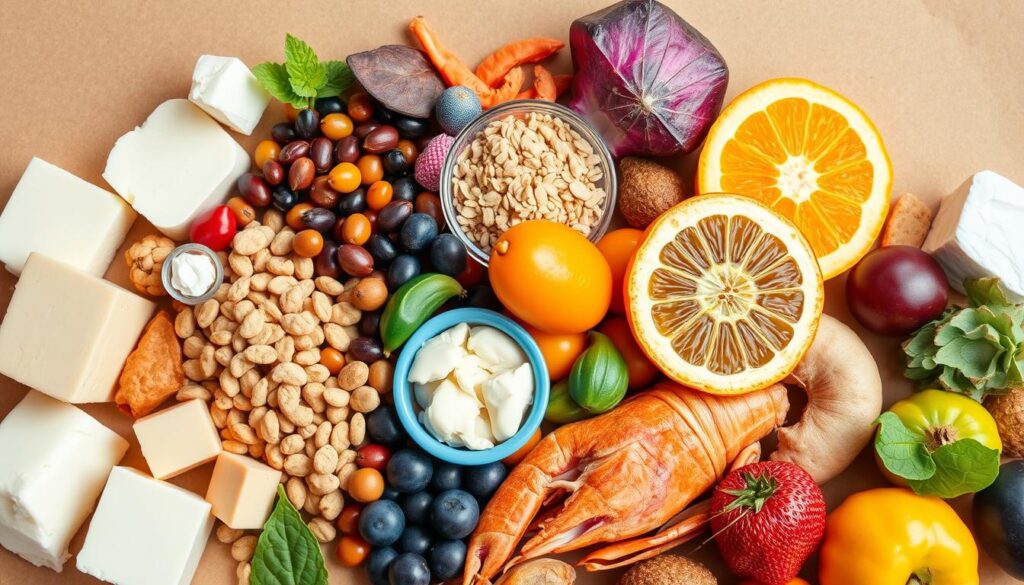Ever felt uncomfortable or had digestive problems after eating some foods? You might have a food intolerance. But what’s the difference between food intolerance and a food allergy? We’ll explore food sensitivities, symptoms, treatments, and managing dietary restrictions.
Imagine enjoying your favorite meals without bloating, gas, or stomach pain. It’s possible! With the right info and tools, you can manage your food intolerance. We’ll look at the differences between food allergies and intolerances, clear up myths, and introduce a game-changing app for food.
Key Takeaways
- Understand the distinction between food allergies and intolerances
- Discover the most common types of food intolerances
- Recognize the diverse range of symptoms associated with food sensitivities
- Learn effective strategies for diagnosing and managing food intolerances
- Explore natural treatment approaches and the benefits of elimination diets
Understanding Food Intolerance vs Food Allergies
It’s important to know the difference between food allergies and intolerances. They can both cause symptoms, but they have different causes and effects. Knowing the difference helps in getting the right treatment.
Key Differences Between Allergies and Intolerances
The main difference is how the immune system reacts. Food allergies happen when the immune system sees a harmless food as a threat. It then attacks it aggressively. Food intolerances, however, don’t involve the immune system. They happen when the body can’t digest or use certain foods right.
Common Misconceptions About Food Reactions
- Myth: All bad food reactions are allergies. But, food intolerances are much more common.
- Myth: Lactose intolerance is a food allergy. It’s actually a food intolerance, not an allergy.
- Myth: Food intolerances are not as serious as food allergies. Both can really affect someone’s life and should be taken seriously.
The Role of Immune System Response
In food allergies, the immune system overreacts to a food protein. This leads to symptoms like hives and swelling. In food intolerances, the body can’t digest certain foods, like lactose or gluten.

Understanding the difference between food allergies and intolerances is key. It helps us find the right way to manage these conditions. By knowing how they work, we can take better care of our health.
Most Common Types of Food Intolerance
There are a few main culprits when it comes to food sensitivities. Let’s explore lactose intolerance and gluten sensitivity. Knowing about these common issues can make navigating our diets easier.
Lactose Intolerance
Lactose intolerance happens when we don’t have enough lactase enzyme. This enzyme breaks down lactose, a sugar in dairy. Symptoms include bloating, gas, and diarrhea after eating dairy products.
Gluten Sensitivity
Gluten sensitivity is a reaction to gluten, found in wheat, barley, and rye. It’s different from celiac disease because it doesn’t involve the immune system. Yet, it can cause stomach issues, fatigue, headaches, and joint pain.
While lactose intolerance and gluten sensitivity are well-known, there are other food intolerances to watch out for. These include reactions to soy, eggs, and nuts. Paying attention to how your body reacts can help manage food sensitivities.
| Type of Food Intolerance | Common Symptoms | Typical Triggers |
|---|---|---|
| Lactose Intolerance | Bloating, gas, diarrhea | Dairy products (milk, cheese, ice cream) |
| Gluten Sensitivity | Digestive issues, fatigue, headaches | Wheat, barley, rye |
| Soy Intolerance | Nausea, vomiting, abdominal pain | Soy-based foods (tofu, edamame, soy sauce) |
| Egg Allergy | Skin rashes, hives, digestive problems | Eggs, baked goods containing eggs |
Managing food sensitivities means listening to your body and getting help from healthcare professionals. With the right support, you can control your diet and live a healthier life.

Recognizing Food Intolerance Symptoms
Understanding food intolerance can be tough. But knowing the signs is key. Symptoms range from digestive issues to non-gut problems. Spotting these patterns helps manage food sensitivities and keeps us healthy.
Digestive System Symptoms
The gut is often the first sign of food intolerance. Look out for bloating, gas, and stomach pain. Also, watch for diarrhea and constipation. These signs show your body might not be digesting some foods right.
Notice how your stomach reacts after eating. These reactions can tell you a lot about your food triggers.
Non-Digestive Symptoms
Food intolerance can also show up in unexpected ways. You might get headaches, feel tired, or have skin issues. Even joint pain and mood swings can be linked to food sensitivities. If you’re dealing with strange symptoms, think about your diet.
Delayed Reaction Patterns
One tricky thing about food intolerance is delayed reactions. Unlike allergies, intolerance symptoms can take hours or days to show up. This makes it hard to find the problem food.
Keeping a food diary is key. It helps you find the connection between food and symptoms. This way, you can make changes to improve your gut health and overall well-being.
Diagnosing Food Sensitivities and Intolerances
Figuring out what foods make you feel bad can be like solving a mystery. Luckily, there are many ways to find out what foods might be causing your discomfort. Let’s look at some methods that can help you feel better.
Food sensitivity testing is a detailed way to find out what foods bother you. It checks how your body reacts to many common foods, like gluten, dairy, soy, and nuts. Knowing what foods you’re sensitive to lets you make a special elimination diet to avoid them.
If you don’t want to do lab tests, an elimination diet can still help. It means removing foods you think might be causing problems from your diet. Then, you add them back one at a time to see if you react. This way, you can figure out which foods you can’t tolerate.
Choosing a method to find food sensitivities is important. Be patient and keep trying, as it might take some time. But, the effort is worth it for a healthier, happier life. The Food Scan Genius app can also be a great help, showing you allergens in your food as you go.
The Impact of Food Intolerance on Daily Life
Living with food intolerances can be tough, but you’re not alone. It affects your social life, emotions, work, and eating out. We’ll look at how dietary restrictions change your daily routine.
Social and Emotional Challenges
Going to social events or eating with friends and family can be hard. The worry of eating something you shouldn’t or feeling like a burden is real. It’s key to talk about your needs and have supportive people around you.
Workplace Considerations
The workplace also has its own hurdles with dietary restrictions. You need to talk about your needs and teach your coworkers. With some planning and talking, you can do well at work and manage your food intolerances.
Travel and Dining Out
Traveling and eating out with friends can be tough with food intolerances. But, doing some research and planning can help. Know where to find allergen-free food, bring snacks, and tell servers about your needs. This way, you can still enjoy traveling and eating out.
Living with food intolerances means making some changes, but it doesn’t control your life. By standing up for yourself and having a supportive group, you can handle daily challenges with strength and kindness.
Natural Treatment Approaches for Food Intolerance
If you’re dealing with food intolerances, there are many natural remedies to try. Focusing on gut health and a holistic approach can help you feel better. Let’s explore some effective natural treatments.
Probiotics: Restoring Gut Balance
Probiotics are live bacteria and yeasts that are great for your gut. They help balance your digestive system, which can be upset by food intolerances. Adding probiotic-rich foods like yogurt, kefir, and fermented veggies to your diet can help reduce symptoms and improve gut function.
Herbal Remedies: Nature’s Soothing Solutions
Many herbs have natural anti-inflammatory and soothing properties. They can ease the discomfort of food intolerances. Ginger, peppermint, and chamomile are examples of herbs that can calm an upset stomach. Talk to a healthcare professional to find the best herbal remedies for you.
Digestive Enzymes: Enhancing Nutrient Absorption
Food intolerances can make it hard for your body to break down and absorb nutrients. Digestive enzymes can help with this. Look for enzyme supplements that target the nutrients you have trouble digesting.
Always talk to a healthcare professional before starting any new treatment, especially if you have multiple food intolerances or complex health conditions. They can help you find the best natural remedies and create a plan to manage your food sensitivities.
“Treating the root cause of food intolerances, rather than just masking the symptoms, is the key to long-term relief and improved quality of life.”
| Natural Remedy | Benefits | Potential Risks |
|---|---|---|
| Probiotics | Restores gut balance, reduces inflammation | May cause temporary gas or bloating |
| Herbal Remedies | Soothes digestive discomfort, has anti-inflammatory properties | Some herbs may interact with medications |
| Digestive Enzymes | Enhances nutrient absorption, aids digestion | May cause allergic reactions in some individuals |
By using these natural treatment approaches, you can actively manage your food intolerances. This can improve your gut health and overall well-being.
How to Create an Elimination Diet Plan
Are you ready to take control of your food sensitivities and discover the root causes of your dietary issues? Creating an elimination diet plan is the key to unlocking a healthier, more vibrant you. Let’s dive in and explore the step-by-step process to get you started.
Planning Phase Steps
- Identify your suspected trigger foods. Common culprits include dairy, gluten, soy, and nuts.
- Eliminate these foods from your diet for a specified period, typically 2-4 weeks.
- Maintain a detailed food journal to track your symptoms and reactions during the elimination phase.
- Consult with a healthcare professional to ensure your elimination diet is safe and tailored to your unique needs.
Reintroduction Guidelines
Once the elimination phase is complete, it’s time to reintroduce the suspected trigger foods, one at a time. This process allows you to pinpoint the specific foods that cause your food sensitivities and dietary restrictions.
- Reintroduce one food at a time, waiting 2-3 days before adding the next.
- Pay close attention to any symptoms or reactions that arise, and document them in your food journal.
- If a food triggers a reaction, remove it from your diet and wait for the symptoms to subside before trying another food.
Monitoring and Documentation
Consistent monitoring and documentation are essential for the success of your elimination diet. Use the Food Scan Genius app to track your progress and identify safe foods during this process.
Remember, creating an elimination diet plan takes time and patience, but the payoff is a healthier, happier you. Stick with it, and you’ll be well on your way to discovering the foods that work best for your body.
Managing Food Intolerance with Technology
Living with food intolerances can be tough, but the future looks bright! The Food Scan Genius app makes it easier to manage your diet. It’s your personal guide for reading food labels and spotting allergens.
Imagine scanning a product’s barcode and knowing if it’s safe for you. The Food Scan Genius app lets you do just that. It helps you choose what’s best for your body.
- Effortlessly check for common allergens like gluten, dairy, nuts, and more.
- Receive detailed nutrient information to ensure you’re meeting your dietary needs.
- Personalize your profile with your specific food sensitivities for tailored recommendations.
No more checking ingredient lists or worrying about reactions. The Food Scan Genius app gives you freedom. It’s a big help for those with food intolerances.
The Food Scan Genius app has been a lifesaver for me. I no longer have to worry about accidentally consuming something that will upset my stomach. It’s like having a personal nutritionist in my pocket.”
End the guessing game and welcome the future of food management. Get the Food Scan Genius app now. Take charge of your diet.
Living with Multiple Food Intolerances
Dealing with food intolerances can be tough, especially when you have many dietary restrictions. But you’re not alone! We’ve got some helpful tips to make managing your diet easier while still enjoying life.
Meal planning is crucial. Take time to check ingredient lists and find safe foods for each intolerance. Pro tip: the Food Scan Genius app can be a real lifesaver here, allowing you to quickly scan products and see if they’re a good fit for your needs.
- Create a master list of approved foods and recipes that cater to all your dietary restrictions.
- Batch cook or meal prep to save time and ensure you always have allergen-free options on hand.
- Explore new, exciting ingredients and recipes that fit your unique dietary needs – get creative in the kitchen!
Eating out with multiple food intolerances can be tricky, but it’s not impossible. Before you dine, do your research and call ahead to communicate your specific dietary requirements. Many restaurants are happy to accommodate special requests and work with you to create a safe and delicious meal.
“Don’t be afraid to speak up and advocate for your needs. Your health and well-being come first!”
Managing food intolerances is a journey, and it may take some time to find your rhythm. Be patient with yourself, listen to your body, and don’t hesitate to seek support from healthcare professionals or join online communities of others navigating similar experiences. Together, we can make living with food intolerances a little easier and a lot more enjoyable.
Conclusion
You’ve made it! This guide has given you great insights into managing food intolerances. You’re not alone in this journey. Many people deal with dietary restrictions.
With tools like the Food Scan Genius app, you can manage your food journey better. This lets you enjoy more freedom and flexibility.
Keep being positive and informed as you explore food intolerance. Know the difference between allergies and intolerances. Also, recognize common symptoms and learn how to treat them.
By following a diet plan made just for you and using technology, you can face the challenges of food intolerances. This includes social, emotional, and practical ones.
If you’re starting or already dealing with food intolerances, this guide has helped you. It’s given you the knowledge and resources to move forward with confidence.
Learn about your body, try new foods, and build a healthy relationship with your diet. With the right mindset and the Food Scan Genius app, you can have a rewarding food journey. It will match your unique needs and preferences.
FAQ
What is the difference between a food allergy and a food intolerance?
A food allergy is a serious immune reaction that can be life-threatening. Food intolerances, on the other hand, are digestive issues. They cause symptoms like bloating and diarrhea. Knowing the difference is key to managing them properly.
What are the most common types of food intolerances?
Lactose intolerance, gluten sensitivity, and reactions to dairy, wheat, or nuts are common. Finding out which foods trigger your intolerance is the first step to managing it.
What are the typical symptoms of food intolerance?
Symptoms of food intolerance include bloating and diarrhea. They can also cause headaches and skin issues. Sometimes, symptoms take time to show up, making it hard to find the cause.
How can I diagnose a food intolerance?
To diagnose a food intolerance, you can try an elimination diet or food sensitivity testing. A healthcare professional can also help. The Food Scan Genius app can identify potential trigger foods.
How can I manage the social and emotional challenges of living with food intolerances?
Dealing with food intolerances can be tough socially and emotionally. But, you can communicate with friends and plan for social events. Remember, you’re not alone in this journey.
What natural treatment approaches can I try for food intolerance?
Improving gut health with probiotics and herbal remedies can help. Dietary changes are also effective. Always talk to a healthcare professional before starting any new treatment.
How do I create an effective elimination diet plan?
Creating a successful elimination diet involves planning and reintroducing foods carefully. Use tools like the Food Scan Genius app to track safe and unsafe foods. This methodical approach is key.
How can the Food Scan Genius app help me manage my food intolerance?
The Food Scan Genius app is a game-changer for managing food intolerances. It lets you scan barcodes and check for allergens. It’s very helpful during the elimination diet and in daily life.
How do I manage multiple food intolerances?
Managing multiple food intolerances is challenging but doable. Meal planning and using tools like the Food Scan Genius app can help. With the right strategies, you can enjoy a healthy diet.





